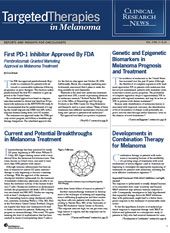Current and Potential Breakthroughs in Melanoma Treatment
Nanotechnology is unlikely to enter the arena of melanoma therapy, overshadowed as it is by the promising developments in combination treatment with immune checkpoint inhibitors, tumor-infiltrating lymphocyte therapies, and other immunotherapies.
Figure.FullereneMolecule.
[Source: Wikimedia commons;http://en.wikipedia.org/wiki/File:C60a.png]
Immunotherapy has been practiced for nearly 125 years, beginning in 1891 when William B. Coley, MD, began treating cancer with a toxin derived from the bacteriumSerratia marcescens. This toxin, known as Coley’s toxin, was used to treat more than 1000 patients with cancer.1
Although immune enhancement has been an area of research for almost 125 years, immunotherapy is only beginning to become a mainstay of therapy. With the approval of the immune checkpoint inhibitor ipilimumab for the treatment of metastatic melanoma, physicians are able to enhance the antitumor activity of the human body’s own T cells. Checkpoint inhibitors in development include the programmed cell death 1 (PD-1) inhibitors nivolumab and MK-3475. Studies are ongoing with at least 7 checkpoint inhibitors.1
By unmasking tumors using checkpoint inhibitors, scientists, including Walter J. Urba, MD, PhD, at the Providence Cancer Center, Portland, Oregon, are hopeful that these new treatments will lead to better outcomes for patients. Reflecting on the progress in immunotherapy, Urba noted, “It’s quite amazing the level of sophistication that has been reached in terms of manipulating these T cells to make them better killers of tumors in patients.”1
Another immunotherapy treatment in development is the technique of isolating and expanding tumor-infiltrating lymphocytes and then reinfusing those cells into patients with melanoma. According to Patrick Hwu, MD, of the University of Texas MD Anderson Cancer Center in Houston, “The response rates are high, we can get some very large tumors to regress, and the responses can be very durable.”1
Because immune-specific therapies depend on the characteristics of individual tumors, the identification of biomarkers is an important part of patient selection. For example, the BRAF inhibitors are only approved for use in patients with selected mutations.1
Although several new treatments will be available in the near future, adverse events (AEs), drug resistance, and cancer relapse remain challenges, especially when these novel treatments are used in combination. Among the promising new additions to treatments are nanoparticles, which are microscopic particles with at least one dimension less than 100 nm. Nanoparticles may provide improved delivery of medication and radiotherapy to the site of a tumor.1,2
Nanoparticles have been tested as both a drug delivery and as a method of targeting melanoma cells in murine melanoma models. Those treatments include nanoparticles that deliver medication preferentially to the site of tumors, nanoparticles that inhibit expression of genes in tumors through small interference RNA (siRNA) technology, and radiation-activated particles.2
Nanoparticles laden with chemotherapeutic agents have been tested in mouse models of melanoma. Investigators conjugated doxorubicin to fullerene nanoparticles (Figure) and compared the efficacy of the nanoparticle formulation with the efficacy of free doxorubicin in a murine model of melanoma. The use of carbon nanostructures allowed scientists to load more than one-third more doxorubicin on each nanoparticle than is enabled by other systems. Fullerenes localized in the lysosomes of melanoma cells preferentially within 2 hours of administration. Free doxorubicin, unlike nanoparticle-formulated doxorubicin, tended to reduce the mass of mice spleen and heart tissue. This data suggest that preferential distribution to tumors through nanoparticle delivery of doxorubicin may reduce the risk of systemic AEs.2,3
In mice, delivery of small interference RNA siRNA through nanoparticles has been used successfully to reduce expression of ribonucleotide reductase and c-Myc gene in melanoma cells. Current siRNA treatments include a cyclodextrin nanoparticle system that was recently investigated in a successful phase Ia/Ib clinical trial.4-6
In 24 patients enrolled in the trial between May 2008 and September 2010, investigators increased the dosage of siRNA-laden nanoparticles from 3 mg/m2to 30 mg/m2. Enrolled patients had several types of cancer, including melanoma (n = 5), gastrointestinal cancer (n = 8), prostate cancer (n = 2), and other types (n = 9). Common AEs included chills and fever. Common severe AEs included lymphopenia, which occurred in 3 patients, and fatigue, which occurred in 2 patients. Less common severe AEs, occurring in 1 patient each, included hypersensitivity, ischemic colitis, diarrhea, and fever. Overall, the treatment was well tolerated, and with these results, trials are expected to progress to phase II.6
In the near future, however, nanotechnology is unlikely to enter the arena of melanoma therapy, overshadowed as it is by the promising developments in combination treatment with immune checkpoint inhibitors, tumor-infiltrating lymphocyte therapies, and other immunotherapies.
References
- Immunotherapy for melanoma: on the brink of a breakthrough. ASCO Daily News.http://am.asco.org/immunotherapy-melanoma-brink-breakthrough. Published May 31, 2014. Accessed July 2014.
- Bombelli FB, Webster CA, Moncrieff M, Sherwood V. The scope of nanoparticle therapies for future metastatic melanoma treatment.Lancet Oncol.2014;15(1):e22-e32.
- Chaudhuri P, Paraskar A, Soni S, Mashelkar RA, Sengupta S. Fullerenol-cytotoxic conjugates for cancer chemotherapy.ACS Nano. 2009;3(9):2505-2514.
- Davis ME, Zuckerman JE, Choi CH, et al. Evidence of RNAi in humans from systemically administered siRNA via targeted nanoparticles.Nature. 2010;464(7291):1067- 1070.
- Chen Y, Bathula SR, Yang Q, Huang L. Targeted nanoparticles deliver siRNA to melanoma.J Invest Dermatol. 2010;130(12):2790-2798.
- Zuckerman JE, Gritli I, Tolcher A, et al. Correlating animal and human phase Ia/Ib clinical data with CALAA- 01, a targeted, polymer-based nanoparticle containing siRNA [published online July 20, 2014].Proc Natl Acad Sci U S A.2014.
Survivorship Care Promotes Evidence-Based Approaches for Quality of Life and Beyond
March 21st 2025Frank J. Penedo, PhD, explains the challenges of survivorship care for patients with cancer and how he implements programs to support patients’ emotional, physical, and practical needs.
Read More
